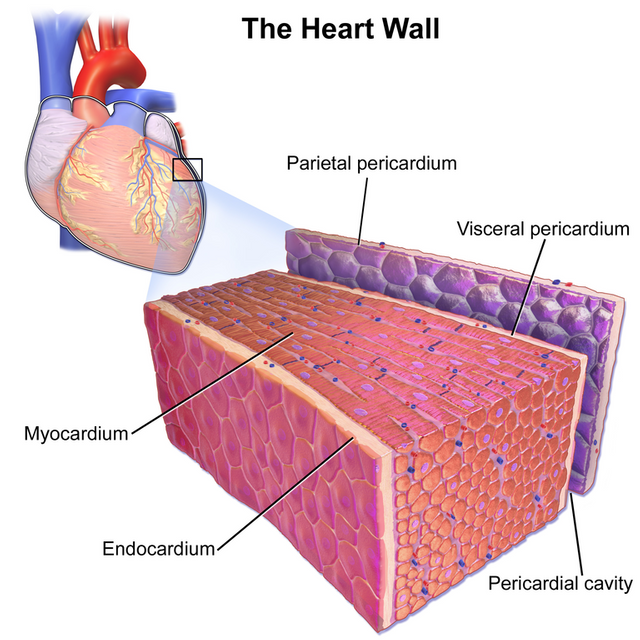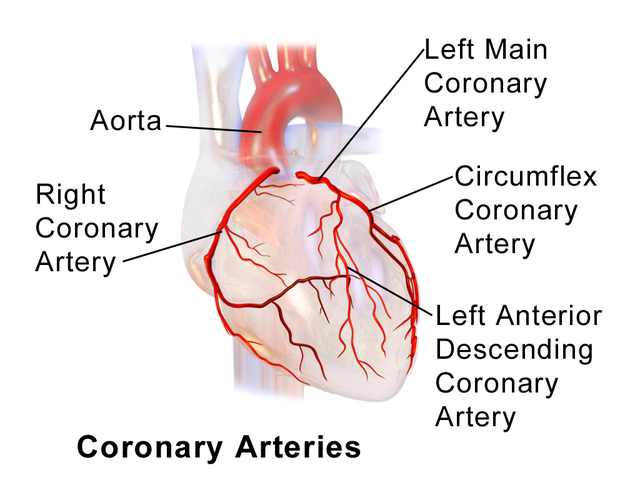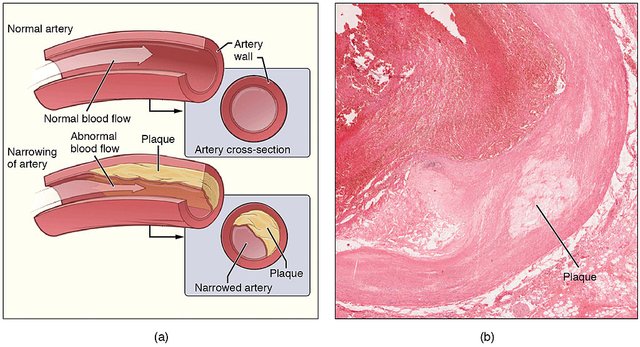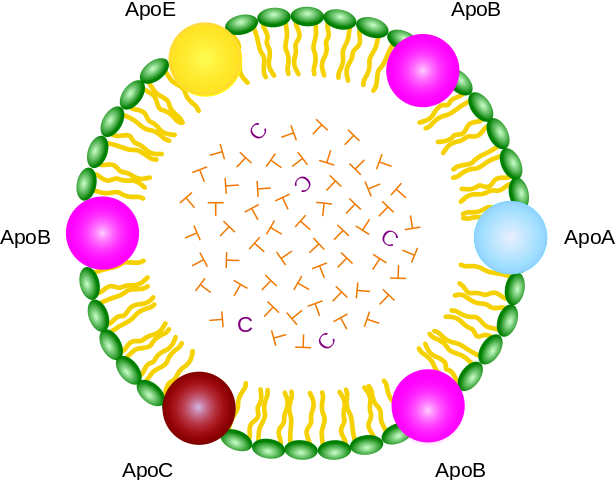Why some healthy individuals die suddenly?
This may seem like an odd question but nevertheless, it's a good one. Hello everyone, I hope you are having a good day, today we're going to discuss a very interesting subject. In your life, you have definitely seen some really sick people, but in surprising scenarios others who look very healthy with no medical history whats or ever die in few seconds! Ever wondered why? The cause is obviously a heart attack in most cases. In fact, the World Health Organization assumes that the majority of deaths across the world are due to cardiovascular diseases.
So if a heart attack can cause a sudden death in a healthy individual, why is that? isn't it supposed to affect sick people ? to have an answer we need to run through some concepts...
The cardiac pump
The heart is a small organ in the chest, it pumps blood to the different organs making it a vital organ.
For example, a lack of blood supply for 2 mins destinated to the neurons in the brain can cause irreversible damage, and that means an altered function because unlike other cells, neurons don't regenerate.
The heart is composed of three main layers: The outer layer or epicardium, The muscle layer or myocardium and the internal layer or endocardium, all of them are trapped in a double-layered small sac called pericardium. The myocardium is the thickest layer, so basically, the heart is a just a big pile of muscles.
The inside of the heart is composed of four different chambers separated by two valves and a septum, we will not go into details for the purpose of the article, you just need to know that :
- The upper right chamber is called the right atrium, it receives the deoxygenated blood from the veins, pass it directly to the low right chamber called the right ventricle.
- The upper left chamber is called the left atrium, it receives the oxygenated blood from the pulmonary veins, pass it directly to the low left chamber called the left ventricle.
- With each contraction the blood is ejected from the right ventricle to the lungs through the pulmonary artery and from the right ventricle to the systemic circulation through the aorta.
The Coronary circulation
Like any other organ, the heart itself consumes oxygen and nutrients to be able to function properly, the only difference is that the heart is working relentlessly which means that it needs oxygen continuously. The blood supply of the heart is ensured by the coronary circulation.
A simplified view of the coronary circulation, notice two arteries arising from the aorta, these are the right and left coronary arteries. They give birth to different branches that irrigate the different layers of layers
The particularity of the coronary circulation is that it's terminal just like the circulation of the kidney, That means each branch is destinated to only one specific region, there isn't a possibility of another supply by other arteries in case of an obstruction, That's pretty bad we don't like that to happen!
Heart attacks or myocardial infarctions are caused by an obstruction of one of the branches of the coronary arteries. In fact, the myocardium can sustain for a little while without oxygen, it switches its metabolism to an anaerobic mode and starts producing more and more lactic acid. It's the same acid accumulation in your muscles that trigger pain after a long period of running and makes you feel tired.
The period of the lack of oxygen supply we call it The golden hour, the faster the person receives a medical treatment the more muscle mass he keeps and the better the outcome.
But what causes the obstruction in the first place?
Most of the time, it's caused by rupture of an atherosclerotic plaques. They are found under the intima (The internal layer which is directly exposed to the lumen of the blood vessel), they composed of external fibrous layers rich in collagen fibers and lipidic cores very rich in cholesterol and immune cells.
Plaques can be found in different sizes and they occupy different arteries in the body, a large plaque can narrow the lumen of the artery and reduce the blood supply causing a permanent stenosis, therefore altering the normal function of the irrigated organ.
In dramatic scenarios, the external fibrous layer is ruptured and the sub-endothelial layer become exposed to the blood, this leads to the beginning of a coagulation cascade and the formation of a blood clot.
The blood clot narrows the lumen even more and causes the severe pain of a typical heart attack, it can be a full obstruction or simply a stenosis, each case is very different from the other one after all having a little bit of blood flow is better than no flow at all. If the blood flow doesn't return in several minutes, the necrosis of myocardiocytes (heart muscle cells) begins. This is a very dangerous outcome because it can lead to a global cardiac failure in the near future.
Sometimes the rupture of the plaque disrupts the normal electrical activity of the heart and causes arrhythmias.
We may see tachycardia (accelerated heartbeats), auricular or ventricular fibrillation (anarchic contractions), conduction disorders etc.. (I advise you to read this article for a further comprehension of these phenomenons)
Ventricular fibrillation is the most dangerous type of arrhythmias because the heart doesn't do its normal pumping anymore and it normally causes death in few seconds. Nevertheless, all these types of heart arrhythmias can stop the heart and cause a sudden death from the beginning without even experiencing any symptom of a heart attack.
What causes the rupture of these plaques you wonder? well, it can be an external choc, a sudden deceleration that transfers the kinetic energy to the body or for now reason at all. If the lipidic core grows a lot and fibrous layer weakens, it may lead to a spontaneous rupture. Age, blood hypertension, and so many other factors may also play a huge factor. So now we know for a fact that the rupture atherosclerotic plaques is the main cause of heart attacks and sudden deaths but still.
How are these plaques formed?
The process of the formation of plaques in the arterial walls is called atherosclerosis, what's scary about this process is that it starts happening in a young age, I'm not talking here about 30 or 40 years nor puberty but from the moment you are a kid!
Your blood carries various lipids cholesterol, fatty acids, triglycerides etc, these molecules are hydrophobe, meaning they don't mix well with water. On a molecular level, they don't elaborate enough hydrogen bonds with H2O molecules to be soluble, in order to carry them on from place to place we need a different transporters.
Lipoproteins are forms of fat transporters in the blood, they can be found in different forms and shapes.
Some examples of lipoproteins include High-density lipoprotein (HDL), Low-density lipoprotein (LDL), Chylomicrons etc..They differ by their shape and structure:
This is a typical model of lipoproteins, the outer layer is formed by a layer of phospholipids with a hydrophile portion facing the blood and a hydrophobe portion facing inside. The layer is stabilized by apolipoproteins, we generally use them to classify the type of the lipoproteins. The core of the chylomicron is rich in triglycerides (main form of fat found in our diets) and cholesterol
Each type of lipoprotein severe an action, HDL, for example, is good for the well-being of the arteries, unlike LDL which is really bad.
The story begins with an alteration of the function endothelial cells, many risk factors are involved such as diabetes, blood hypertension, dyslipidemia, inflammatory conditions, free radicals from smoking but also genetic factors. The formation of plaques is really complex and multifactorial.
Anyway, the endothelial wall is altered, now LDL can pass easily through the cell's membrane on to the subendothelial space and become highly oxidized.Like any other oxidized substance in the body, it's seen as a harmful thing so the endothelial cells start expressing surface molecules mainly selectins and VCAM-1 which are very chemoattractants. These molecules lure the immune cells to the subendothelial space especially monocytes and macrophages. They initiate some sort of inflammatory response and the monocyte become foamy cells that are able to accumulate cholesterol relentlessly and without anything stopping them through a process called the scavenger pathway. As the lipidic core grows bigger and bigger a layer of fibrosis is formed due to the accumulation of collagen and a plaque is formed.
Most of the cases the plaque is stabilized but sometimes, it can be ruptured for a reason or no specific reason. In fact as the excess of cholesterol increases, the internal tension increases and this lead to the destabilization of the plaque.
But then why we don't have something like a kidney attack or a liver attack?
It's actually a pretty good question, you see any artery that is mechanically solicited a lot and prone to consistent changes in blood pressure develops plaques more easily.
Plaques can be seen in the abdominal aorta, narrow the lumen and cause walking problems or in the arteries destinated to the brain. Don't forget that the heart works 24/24 hours and even after the formation of a stabilized plaque, the contractions can be the cause of the rupture in the first place.
Conclusion
I hope that I've answered the majority of your questions and if you have one, make sure to leave a comment below.
Now to answer the first question of the article, atherosclerosis is a silent disease affecting your arteries from a young age, you can pass your entire live practically healthy until the rupture of one plaque someday, the clinical expression can be a simple heart attack or a sudden death. Meanwhile, you can have plaques but you'll never experience any disease at all, only by following a healthy diet and having a good lifestyle you can minimize the risk of cardiovascular diseases.
Sources and useful links for further reading:
Pathophysiology and treatment of atherosclerosis
Prevention of cardiovascular diseases
One more thing, Join the @steemSTEM community, A community project to promote science technology engineering and mathematics postings on Steemit.





Hi, @fancybrothers.
It is not technically wrong but I would write it as "it pumps blood to the different organs making it a vital organ". It is not only vital for a heart to pump oxygenated blood to different organs, but it also serves an important organ for pumping deoxygenated blood to the lung to be reoxygenated.
It is also worth noting that the event of atherosclerosis was not triggered by a high blood cholesterol (most laymen think it is) but conditions which can cause inflammation to the vessels. In order to mend the damage caused by the inflammation, our body recruits various things including cholesterols. Blaming cholesterol for a atherosclerosis is like blaming a fireman for a fire.
Great article! Keep it up!
One of the reasons being cholesterol is one of the components of the atherosclerotic plaque which has been formed surrounding the vessel walls. When there is inflammation, you can imagine a cut is being made on the vessels surface which would trigger the body repair mechanism to act on the imaginary cut by recruiting platelets, macrophage and cholesterol to mend that. Cholesterol technically doesn't cause atherosclerosis. It just one of the component of atherosclerosis and the triggering factor was the inflammation (diabetes mellitus, high triglycerides level).
There are various studies which have been conducted in the past proving that people who have a low level of cholesterol have a high cardiovascular morbidity rate compared to people who have a high blood cholesterol. It's quite controversial and contradicts most of the things that we know about cholesterol but just because it is not supported by the majority of studies, doesn't mean it is wrong. It still within a grey area of research.
I see your point and i'm litterally very confused now, i've heard about the cholesterol consipracy a long time ago but i didn't believe it.I spent the last hour reading researchs and all i can say to you, there's a huge gap in the resarchs and a lot of controversy.
That's my conclusion:
I don't know if you know about the scavanger pathway, it's the process of accumulating cholesterol in the plaques. There's no feeback so that's why they are prone to become bigger and bigger .Anyway high level cholesterol is indeed associated with more risk of cardiovascular disease and that makes sense if you think about it, the excessive amount of cholesterol is put into the arteries through the same pathways. But still we don't know for fact that the cholesterol cause or not the endothelial dysfunction, i guess that' the whole problem regarding the studies.
Hahaha. Good conclusion though.
Thanks ! Nice chatting with you ^^
@fancybrothers
@chloroform
Interesting conversation guys and a good read. I think the process can be more easily summarised if we consider inflammation and damage as the triggers for atherosclerotic events, while cholesterol is an opportunistic infiltrator of arteries.
I'm not aware of any research that treats lipids or cholesterol as molecules that are actively 'recruited' in an attempt to repair endovascular damage. I believe the working hypothesis more sees cholesterol as an infiltrate, which is consumed by local macrophages in an attempt to 'clean' the site. Obviously, these macrophages cannot deal with such large levels of cholesterol and become foam cells which form the basis of vascular thickening.
Higher levels of cholesterol simply means a larger amount of cholesterol for the macrophages to consume.
It's well understood that inflammatory states are big risk factors for atherosclerotic and cardiovascular disease, which is why rheumatoid arthritis leads to heart and lung disease for example. But I don't think cholesterol can be ruled out so easily. Medical consensus doesn't ever come off the back of one study, or one person's work, it doesn't even stem from what is or isn't FDA approved seeing as medical consensus is global.
While our understanding of fat and cholesterol is still evolving, we do know that high blood cholesterol especially if associated with a low HDL is a strong risk factor for atherosclerotic-related diseases. It's more complex than more = worse, but in a broad sense, it does equal less = safer. The discord here is that the body can regulate its blood cholesterol, so high fat or cholesterol diets DO NOT have a relationship with high blood cholesterol, i quote "dietary cholesterol has a small effect on the plasma cholesterol levels with an increase in the cholesterol content of the LDL particle and an increase in HDL cholesterol, with little effect on the LDL:HDL ratio, a significant indicator of heart disease risk". Also, remember (western) high-fat diets don't only lead to hypercholesterinaemia but also obesity and other gastrointestinal conditions like reflux and biliary cholic etc.
With regards to the video you shared... well it falls into all of the pseudoscience pitfalls... ie. 1. "it's called a hypothesis because it's never been proven"; 2. using cute but physiologically irrelevant metaphors to try and explain-away the risks of fat consumption; 3. drawing loops through a graph that has a clear trend. So I'm not giving it too much credibility. I'd also like to say that this wasn't the work of one man in the hand of pharma companies, it was a broader scientific consensus very consistent with the data we had at the time.
@tfcoates Great analysis ! You mentionned that we need first a damage in the arterial wall, it can be caused by a lot of conditions and risk factors, then comes cholesterol as an opportunistic infiltrator.Well that's my point but still can high cholesterol levels cause arterial damage in the first place ? I checked your profile (By the way it's a great one )and i can see that you are a med student, so have you ever heard about Familial hypercholesterolemia (FH) ? It's a condition marked by high LDL and choesterol levels from birth, generally these individuals die from heart attacks before the age of 20 ! And that's only one dyslipidemia, there are countless diseases out there
Great article, resteemed!
I really appreciate that ! thanks ;)
24/7 would be better. Awesome article. Keep on educating people on such topics.
24/24 or 24/7 are the same thing my friend as long as you get the idea :)
I will do without a doubt , thanks for stopping by :)Congratulations! This post has been upvoted from the communal account, @minnowsupport, by Fancybrothers from the Minnow Support Project. It's a witness project run by aggroed, ausbitbank, teamsteem, theprophet0, someguy123, neoxian, followbtcnews, and netuoso. The goal is to help Steemit grow by supporting Minnows. Please find us at the Peace, Abundance, and Liberty Network (PALnet) Discord Channel. It's a completely public and open space to all members of the Steemit community who voluntarily choose to be there.
If you would like to delegate to the Minnow Support Project you can do so by clicking on the following links: 50SP, 100SP, 250SP, 500SP, 1000SP, 5000SP.
Be sure to leave at least 50SP undelegated on your account.